2013 FORD SUPER DUTY fuel pressure
[x] Cancel search: fuel pressurePage 4 of 95

BREAKING-IN YOUR VEHICLE
Your vehicle does not need an extensive break-in. Try not to drive
continuously at the same speed for the first 1,000 miles
(1,600 kilometers) of new vehicle operation. Vary your speed to allow
parts to adjust themselves to other parts.
Drive your new vehicle at least 500 miles (800 kilometers) before towing
a trailer. Make sure you use the specified engine oil by checking the
engine oil specification chart underEngine oilin theMaintenance
chapter.
Do not add friction modifier compounds or special break-in oils during
the first few thousand miles (kilometers) of operation, since these
additives may prevent piston ring seating. SeeEngine oilin the
Maintenancechapter of this supplement for more information on oil
usage.
DIESEL ENGINE INFORMATION
The diesel engine fuel system is a pressurized two-stage filtration system
and consists of:
•a frame-mounted diesel fuel conditioner module (DFCM) / primary
filter with an electric fuel pump and water drain,
•an engine-mounted secondary fuel filter,
•a fuel injector for each cylinder (8 total),
•a high-pressure fuel pump,
•a high-pressure fuel rail for each cylinder bank (2 total) and
•numerous high-pressure pipes from the high-pressure pump to the
rails, and rails to the injectors.
The DFCM acts as a primary fuel filter/water separator which removes
both water and impurities from the fuel. The engine mounted filter filters
finer impurities from the diesel fuel. The engine-mounted fuel filter and
the DFCM filter should be changed at the recommended service interval
or when indicated by the information displayLOW FUEL PRESSURE
message. Refer to thescheduled maintenance informationin this
supplement for more information.
The DFCM should be drained at regular intervals (recommended at
every oil change) or when indicated by the information display and water
in fuel indicator light. SeeFuel filter/water separatorin theFuel and
refuelingchapter.
Introduction
3
2013 Diesel(67l)
Supplement, 1st Printing
USA(fus)
Page 5 of 95
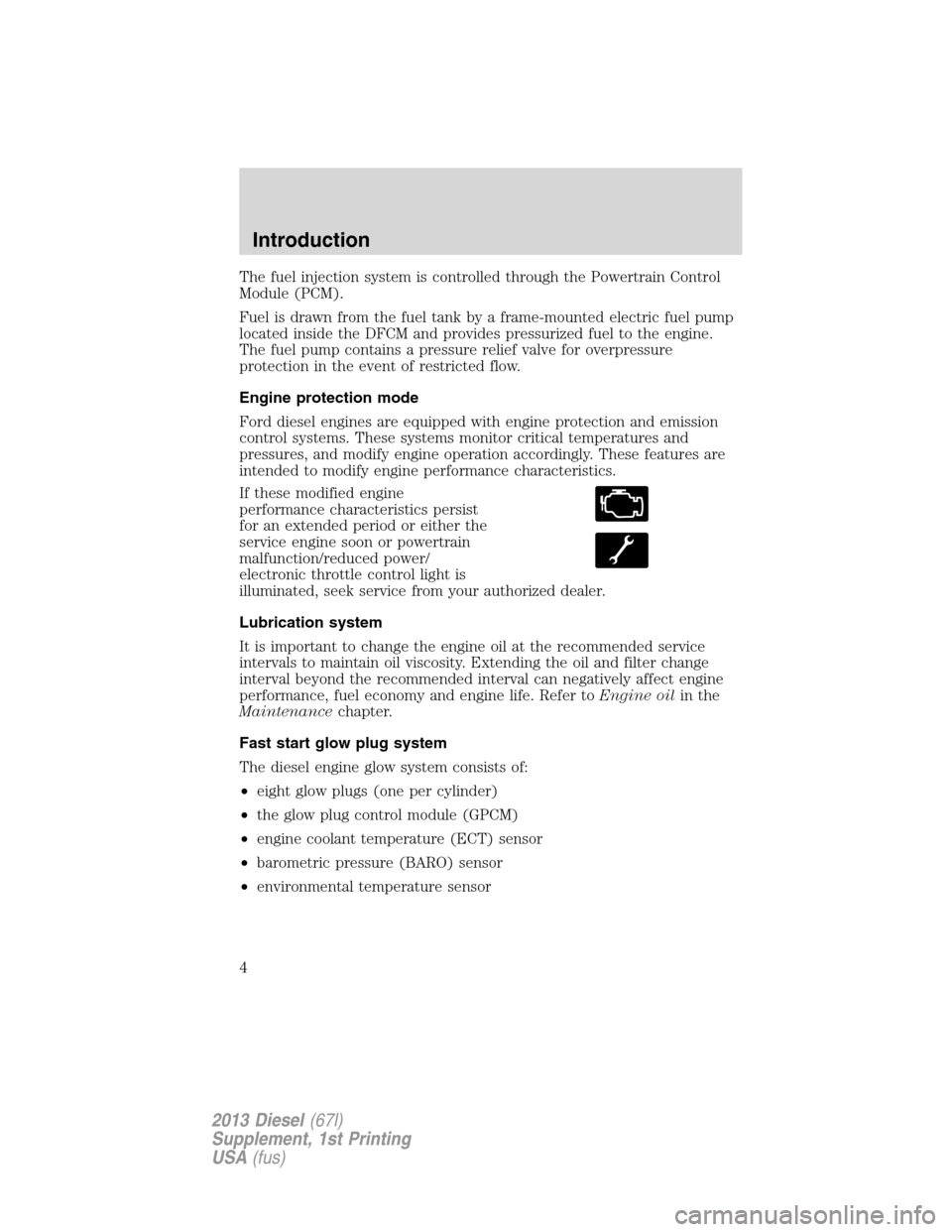
The fuel injection system is controlled through the Powertrain Control
Module (PCM).
Fuel is drawn from the fuel tank by a frame-mounted electric fuel pump
located inside the DFCM and provides pressurized fuel to the engine.
The fuel pump contains a pressure relief valve for overpressure
protection in the event of restricted flow.
Engine protection mode
Ford diesel engines are equipped with engine protection and emission
control systems. These systems monitor critical temperatures and
pressures, and modify engine operation accordingly. These features are
intended to modify engine performance characteristics.
If these modified engine
performance characteristics persist
for an extended period or either the
service engine soon or powertrain
malfunction/reduced power/
electronic throttle control light is
illuminated, seek service from your authorized dealer.
Lubrication system
It is important to change the engine oil at the recommended service
intervals to maintain oil viscosity. Extending the oil and filter change
interval beyond the recommended interval can negatively affect engine
performance, fuel economy and engine life. Refer toEngine oilin the
Maintenancechapter.
Fast start glow plug system
The diesel engine glow system consists of:
•eight glow plugs (one per cylinder)
•the glow plug control module (GPCM)
•engine coolant temperature (ECT) sensor
•barometric pressure (BARO) sensor
•environmental temperature sensor
Introduction
4
2013 Diesel(67l)
Supplement, 1st Printing
USA(fus)
Page 6 of 95
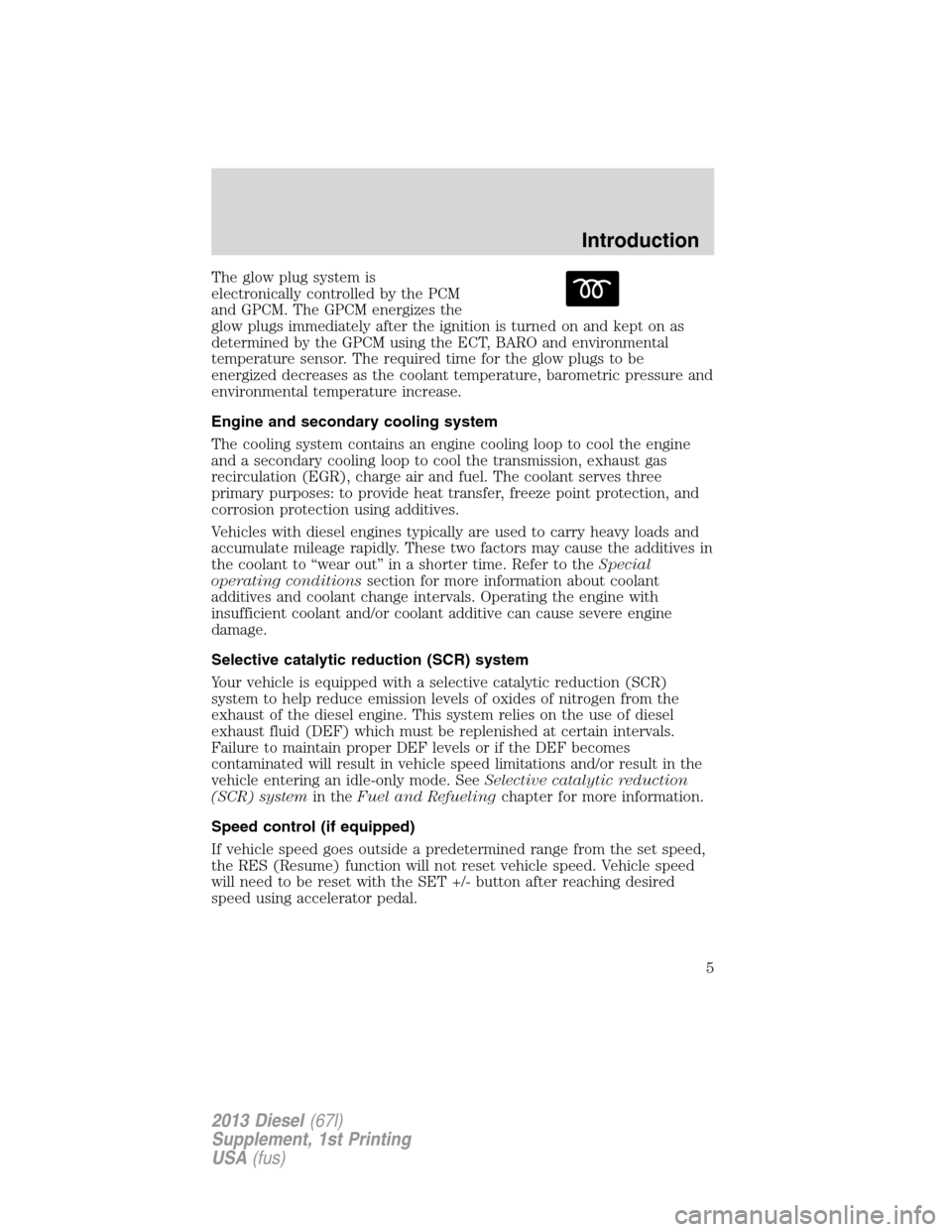
The glow plug system is
electronically controlled by the PCM
and GPCM. The GPCM energizes the
glow plugs immediately after the ignition is turned on and kept on as
determined by the GPCM using the ECT, BARO and environmental
temperature sensor. The required time for the glow plugs to be
energized decreases as the coolant temperature, barometric pressure and
environmental temperature increase.
Engine and secondary cooling system
The cooling system contains an engine cooling loop to cool the engine
and a secondary cooling loop to cool the transmission, exhaust gas
recirculation (EGR), charge air and fuel. The coolant serves three
primary purposes: to provide heat transfer, freeze point protection, and
corrosion protection using additives.
Vehicles with diesel engines typically are used to carry heavy loads and
accumulate mileage rapidly. These two factors may cause the additives in
the coolant to “wear out” in a shorter time. Refer to theSpecial
operating conditionssection for more information about coolant
additives and coolant change intervals. Operating the engine with
insufficient coolant and/or coolant additive can cause severe engine
damage.
Selective catalytic reduction (SCR) system
Your vehicle is equipped with a selective catalytic reduction (SCR)
system to help reduce emission levels of oxides of nitrogen from the
exhaust of the diesel engine. This system relies on the use of diesel
exhaust fluid (DEF) which must be replenished at certain intervals.
Failure to maintain proper DEF levels or if the DEF becomes
contaminated will result in vehicle speed limitations and/or result in the
vehicle entering an idle-only mode. SeeSelective catalytic reduction
(SCR) systemin theFuel and Refuelingchapter for more information.
Speed control (if equipped)
If vehicle speed goes outside a predetermined range from the set speed,
the RES (Resume) function will not reset vehicle speed. Vehicle speed
will need to be reset with the SET +/- button after reaching desired
speed using accelerator pedal.
Introduction
5
2013 Diesel(67l)
Supplement, 1st Printing
USA(fus)
Page 17 of 95
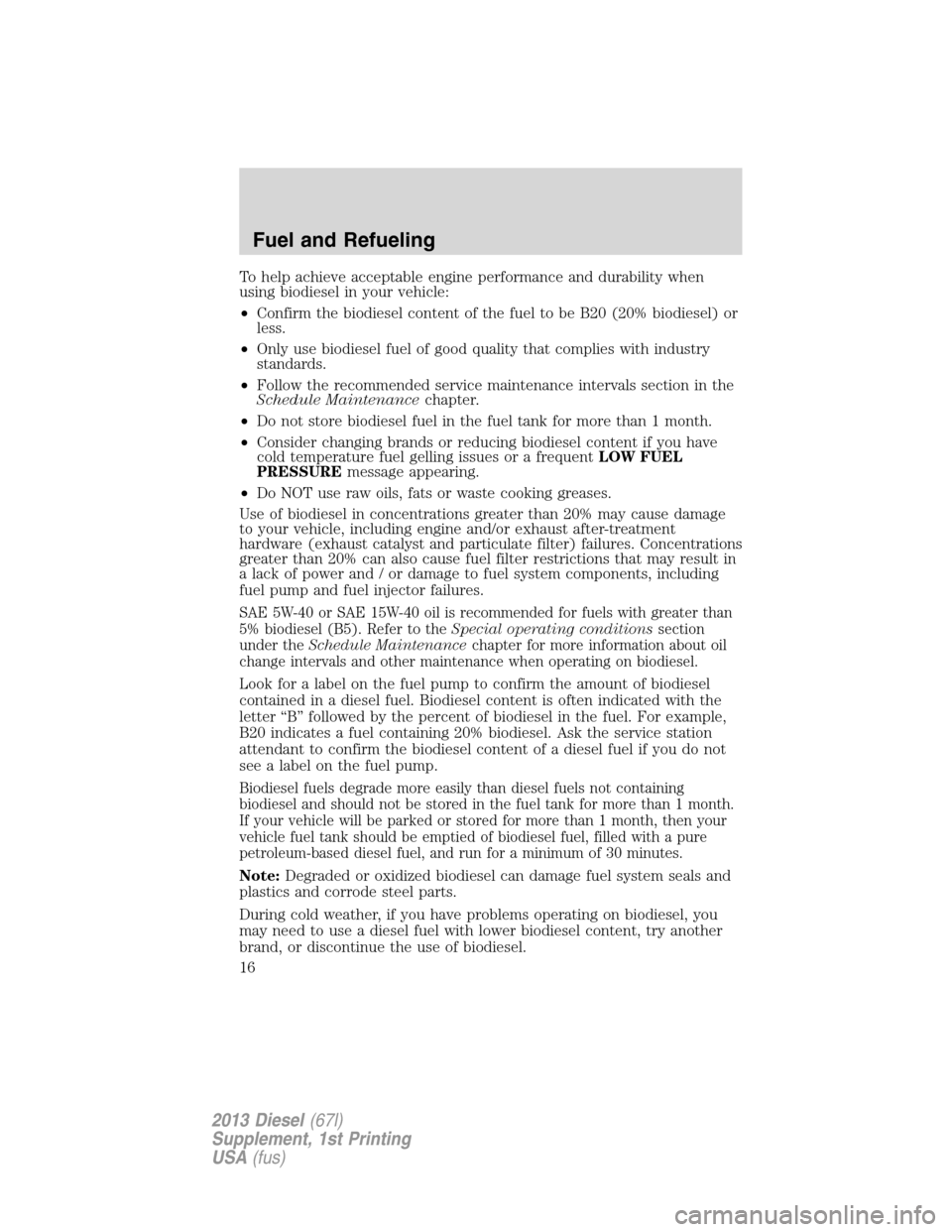
To help achieve acceptable engine performance and durability when
using biodiesel in your vehicle:
•Confirm the biodiesel content of the fuel to be B20 (20% biodiesel) or
less.
•Only use biodiesel fuel of good quality that complies with industry
standards.
•Follow the recommended service maintenance intervals section in the
Schedule Maintenancechapter.
•Do not store biodiesel fuel in the fuel tank for more than 1 month.
•Consider changing brands or reducing biodiesel content if you have
cold temperature fuel gelling issues or a frequentLOW FUEL
PRESSUREmessage appearing.
•Do NOT use raw oils, fats or waste cooking greases.
Use of biodiesel in concentrations greater than 20% may cause damage
to your vehicle, including engine and/or exhaust after-treatment
hardware (exhaust catalyst and particulate filter) failures. Concentrations
greater than 20% can also cause fuel filter restrictions that may result in
a lack of power and / or damage to fuel system components, including
fuel pump and fuel injector failures.
SAE 5W-40 or SAE 15W-40 oil is recommended for fuels with greater than
5% biodiesel (B5). Refer to theSpecial operating conditionssection
under theSchedule Maintenancechapter for more information about oil
change intervals and other maintenance when operating on biodiesel.
Look for a label on the fuel pump to confirm the amount of biodiesel
contained in a diesel fuel. Biodiesel content is often indicated with the
letter “B” followed by the percent of biodiesel in the fuel. For example,
B20 indicates a fuel containing 20% biodiesel. Ask the service station
attendant to confirm the biodiesel content of a diesel fuel if you do not
see a label on the fuel pump.
Biodiesel fuels degrade more easily than diesel fuels not containing
biodiesel and should not be stored in the fuel tank for more than 1 month.
If your vehicle will be parked or stored for more than 1 month, then your
vehicle fuel tank should be emptied of biodiesel fuel, filled with a pure
petroleum-based diesel fuel, and run for a minimum of 30 minutes.
Note:Degraded or oxidized biodiesel can damage fuel system seals and
plastics and corrode steel parts.
During cold weather, if you have problems operating on biodiesel, you
may need to use a diesel fuel with lower biodiesel content, try another
brand, or discontinue the use of biodiesel.
Fuel and Refueling
16
2013 Diesel(67l)
Supplement, 1st Printing
USA(fus)
Page 19 of 95
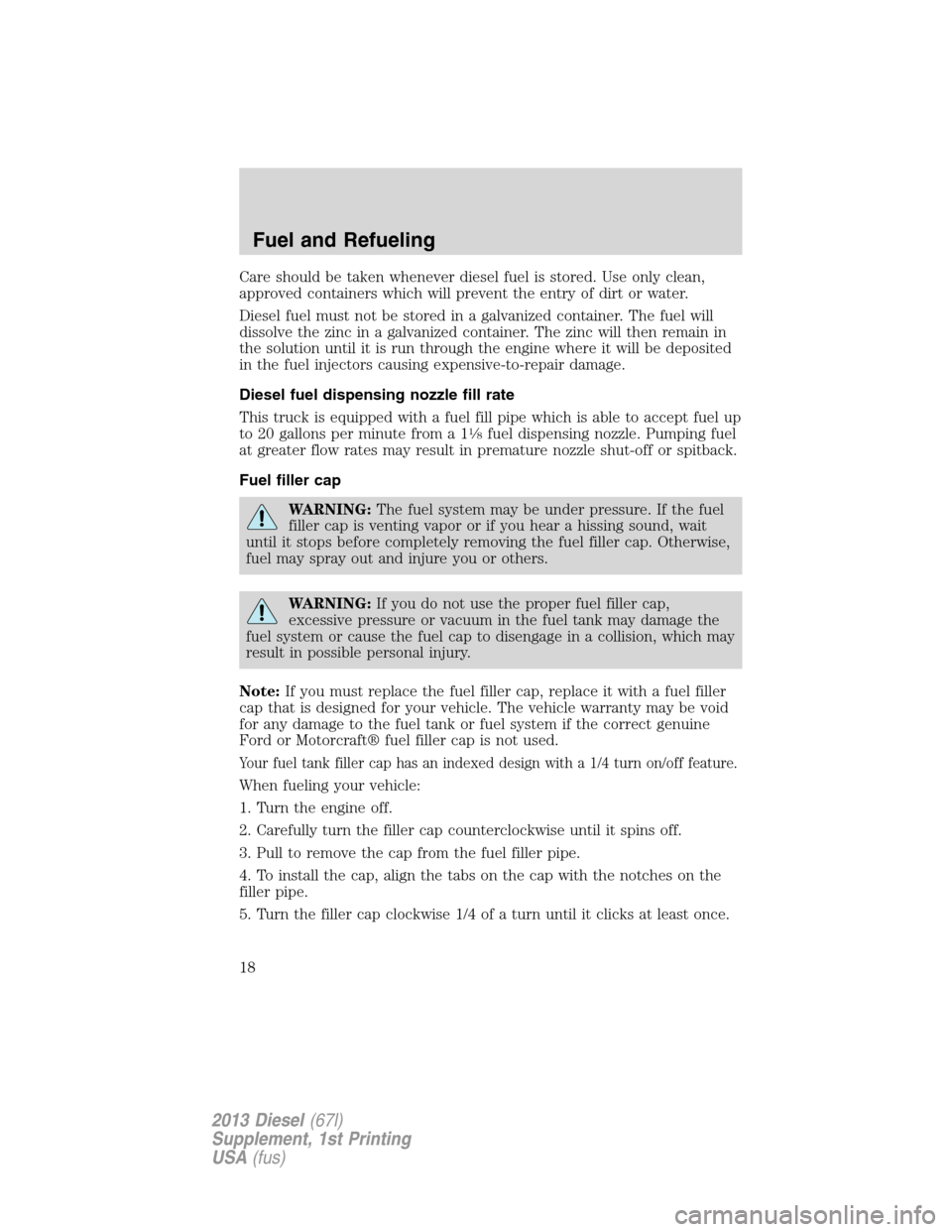
Care should be taken whenever diesel fuel is stored. Use only clean,
approved containers which will prevent the entry of dirt or water.
Diesel fuel must not be stored in a galvanized container. The fuel will
dissolve the zinc in a galvanized container. The zinc will then remain in
the solution until it is run through the engine where it will be deposited
in the fuel injectors causing expensive-to-repair damage.
Diesel fuel dispensing nozzle fill rate
This truck is equipped with a fuel fill pipe which is able to accept fuel up
to 20 gallons per minute from a 1
1�8fuel dispensing nozzle. Pumping fuel
at greater flow rates may result in premature nozzle shut-off or spitback.
Fuel filler cap
WARNING:The fuel system may be under pressure. If the fuel
filler cap is venting vapor or if you hear a hissing sound, wait
until it stops before completely removing the fuel filler cap. Otherwise,
fuel may spray out and injure you or others.
WARNING:If you do not use the proper fuel filler cap,
excessive pressure or vacuum in the fuel tank may damage the
fuel system or cause the fuel cap to disengage in a collision, which may
result in possible personal injury.
Note:If you must replace the fuel filler cap, replace it with a fuel filler
cap that is designed for your vehicle. The vehicle warranty may be void
for any damage to the fuel tank or fuel system if the correct genuine
Ford or Motorcraft® fuel filler cap is not used.
Your fuel tank filler cap has an indexed design with a 1/4 turn on/off feature.
When fueling your vehicle:
1. Turn the engine off.
2. Carefully turn the filler cap counterclockwise until it spins off.
3. Pull to remove the cap from the fuel filler pipe.
4. To install the cap, align the tabs on the cap with the notches on the
filler pipe.
5. Turn the filler cap clockwise 1/4 of a turn until it clicks at least once.
Fuel and Refueling
18
2013 Diesel(67l)
Supplement, 1st Printing
USA(fus)
Page 32 of 95
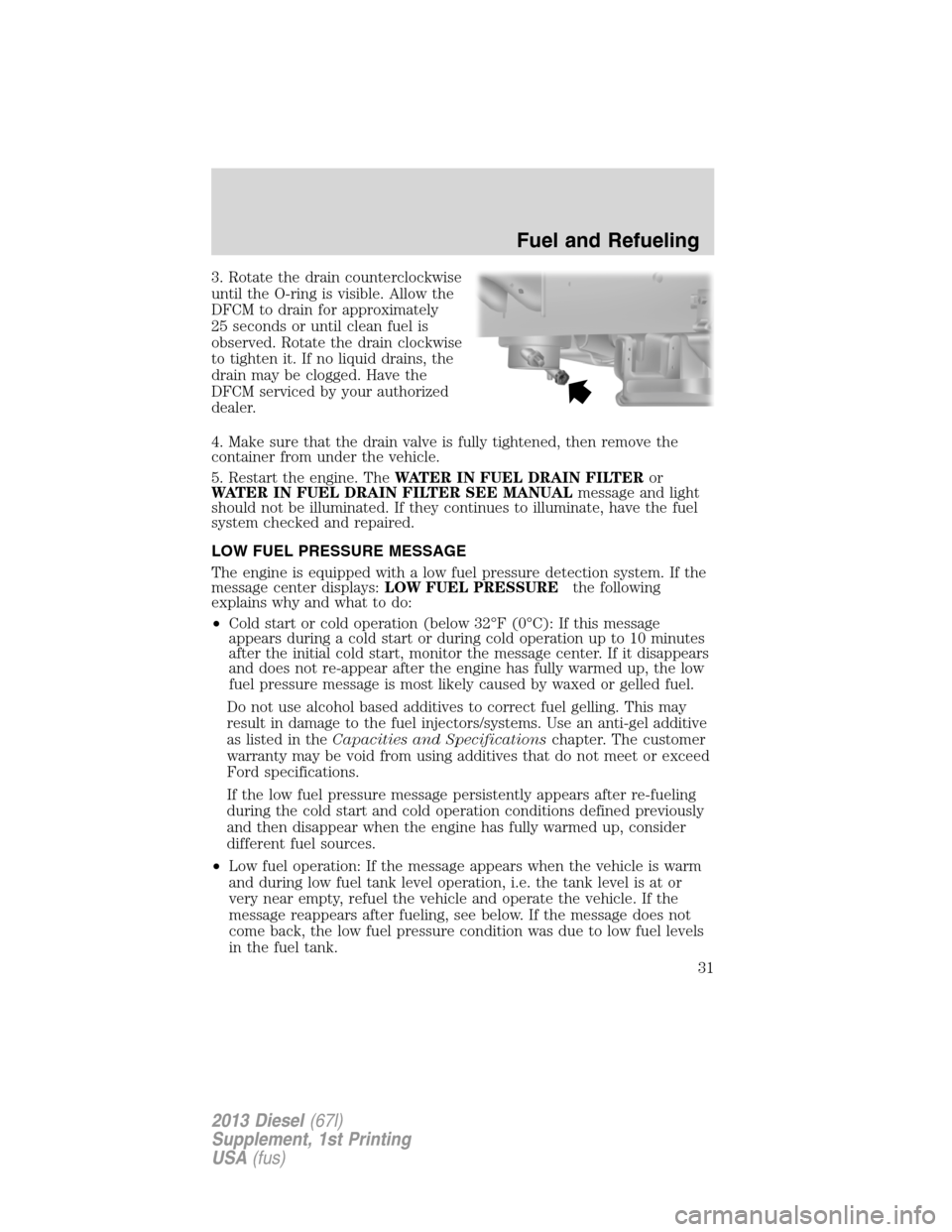
3. Rotate the drain counterclockwise
until the O-ring is visible. Allow the
DFCM to drain for approximately
25 seconds or until clean fuel is
observed. Rotate the drain clockwise
to tighten it. If no liquid drains, the
drain may be clogged. Have the
DFCM serviced by your authorized
dealer.
4. Make sure that the drain valve is fully tightened, then remove the
container from under the vehicle.
5. Restart the engine. TheWATER IN FUEL DRAIN FILTERor
WATER IN FUEL DRAIN FILTER SEE MANUALmessage and light
should not be illuminated. If they continues to illuminate, have the fuel
system checked and repaired.
LOW FUEL PRESSURE MESSAGE
The engine is equipped with a low fuel pressure detection system. If the
message center displays:LOW FUEL PRESSUREthe following
explains why and what to do:
•Cold start or cold operation (below 32°F (0°C): If this message
appears during a cold start or during cold operation up to 10 minutes
after the initial cold start, monitor the message center. If it disappears
and does not re-appear after the engine has fully warmed up, the low
fuel pressure message is most likely caused by waxed or gelled fuel.
Do not use alcohol based additives to correct fuel gelling. This may
result in damage to the fuel injectors/systems. Use an anti-gel additive
as listed in theCapacities and Specificationschapter. The customer
warranty may be void from using additives that do not meet or exceed
Ford specifications.
If the low fuel pressure message persistently appears after re-fueling
during the cold start and cold operation conditions defined previously
and then disappear when the engine has fully warmed up, consider
different fuel sources.
•Low fuel operation: If the message appears when the vehicle is warm
and during low fuel tank level operation, i.e. the tank level is at or
very near empty, refuel the vehicle and operate the vehicle. If the
message reappears after fueling, see below. If the message does not
come back, the low fuel pressure condition was due to low fuel levels
in the fuel tank.
Fuel and Refueling
31
2013 Diesel(67l)
Supplement, 1st Printing
USA(fus)
Page 33 of 95
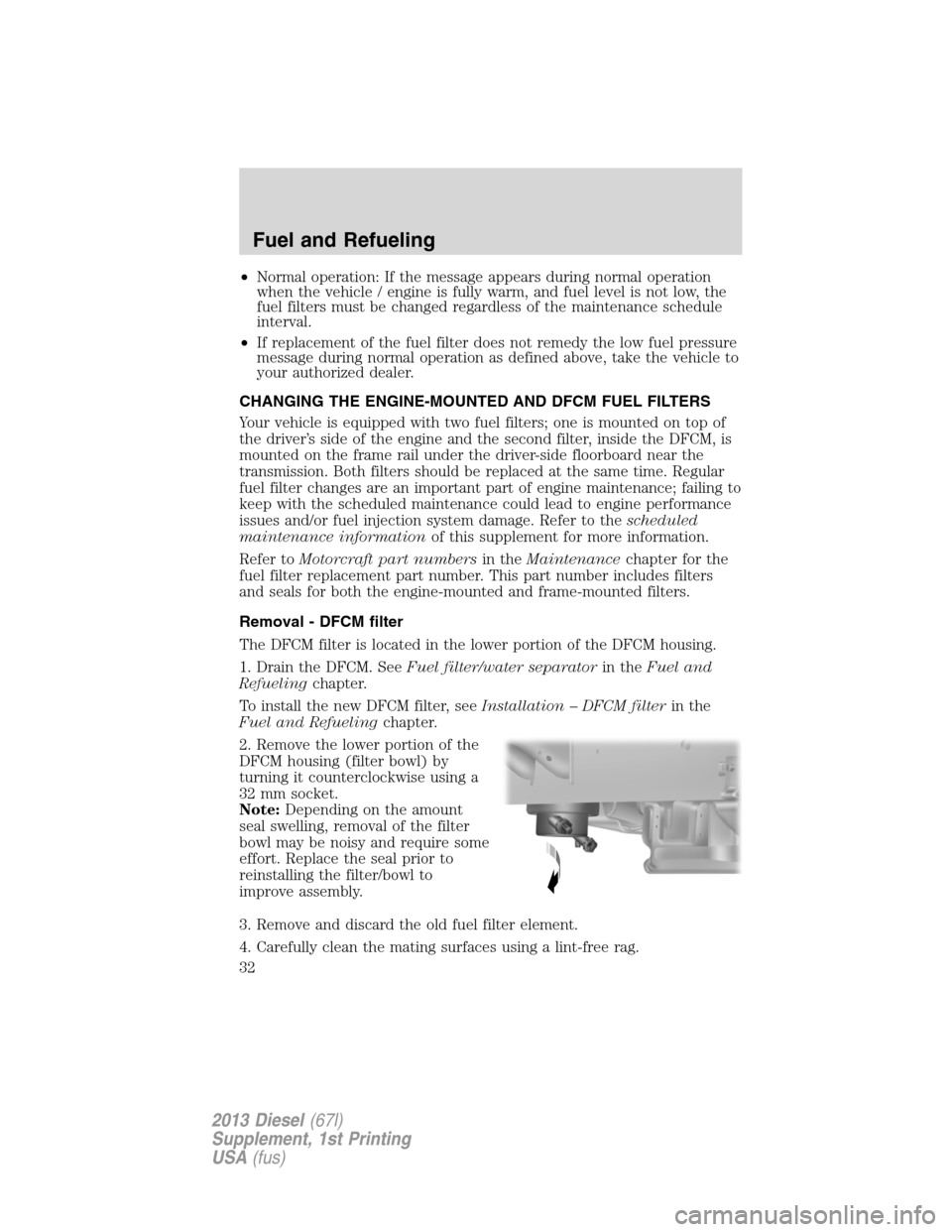
•Normal operation: If the message appears during normal operation
when the vehicle / engine is fully warm, and fuel level is not low, the
fuel filters must be changed regardless of the maintenance schedule
interval.
•If replacement of the fuel filter does not remedy the low fuel pressure
message during normal operation as defined above, take the vehicle to
your authorized dealer.
CHANGING THE ENGINE-MOUNTED AND DFCM FUEL FILTERS
Your vehicle is equipped with two fuel filters; one is mounted on top of
the driver’s side of the engine and the second filter, inside the DFCM, is
mounted on the frame rail under the driver-side floorboard near the
transmission. Both filters should be replaced at the same time. Regular
fuel filter changes are an important part of engine maintenance; failing to
keep with the scheduled maintenance could lead to engine performance
issues and/or fuel injection system damage. Refer to thescheduled
maintenance informationof this supplement for more information.
Refer toMotorcraft part numbersin theMaintenancechapter for the
fuel filter replacement part number. This part number includes filters
and seals for both the engine-mounted and frame-mounted filters.
Removal - DFCM filter
The DFCM filter is located in the lower portion of the DFCM housing.
1. Drain the DFCM. SeeFuel filter/water separatorin theFuel and
Refuelingchapter.
To install the new DFCM filter, seeInstallation – DFCM filterin the
Fuel and Refuelingchapter.
2. Remove the lower portion of the
DFCM housing (filter bowl) by
turning it counterclockwise using a
32 mm socket.
Note:Depending on the amount
seal swelling, removal of the filter
bowl may be noisy and require some
effort. Replace the seal prior to
reinstalling the filter/bowl to
improve assembly.
3. Remove and discard the old fuel filter element.
4. Carefully clean the mating surfaces using a lint-free rag.
Fuel and Refueling
32
2013 Diesel(67l)
Supplement, 1st Printing
USA(fus)
Page 34 of 95

Installation – DFCM filter
1. Install the new filter into the filter bowl tabs and replace the seal on
the DFCM header (top portion of DFCM). Refer toMotorcraft part
numbersin theMaintenancechapter for the fuel filter kit part number.
2. Lube O-ring with lubricant packet in the filter kit. This will assist in
making sure the filter gets properly tightened.
3. Reinstall the lower portion of the
housing by slowly turning it
clockwise onto DFCM housing,
allowing fuel to soak into the fuel
filter element. Tighten the lower
housing until it contacts the
mechanical stop.
Note:The engine will not run
properly if the DFCM fuel filter is
not installed in the housing or if the
filter bowl is not tightened to the
mechanical stop.
The system will need to be purged of air after removal/changing of the
filter. SeePurging air from the fuel system after DFCM and engine
mounted fuel filter replacementfollowing.
Removal - Engine-mounted fuel filter
The engine-mounted fuel filter is a plastic disposable cartridge. To
remove it, do the following:
1. Disconnect both fuel lines by
squeezing the connector tabs and
pulling the lines straight off.
Note:Although the fuel system is
not fully pressurized when the
vehicle is off, some residual
pressure may remain in the fuel
system since it can take some time
for the pressure to completely bleed
off. Therefore, it is recommended to
place a shop rag below the filter
connectors to absorb the small amount of fuel that will drain.
Fuel and Refueling
33
2013 Diesel(67l)
Supplement, 1st Printing
USA(fus)